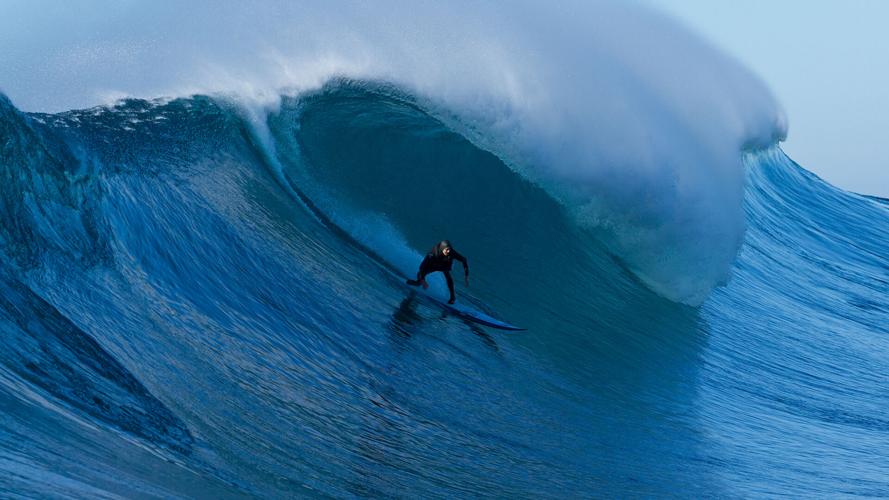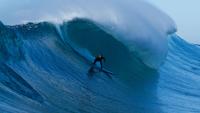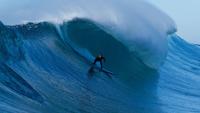With the big-wave winter season at hand, will we see history be made this winter 100 miles offshore?
By Jake Howard
In the early 1990s, Surfline founder Sean Collins, Surfing magazine photo editor Larry “Flame” Moore and pilot Mike Castillo made a discovery off the Southern California coast: the Cortes Bank.
Cortes was actually fairly well known at the time. Popular with fishermen and divers, it gained some notoriety on Nov. 2, 1985, when the nuclear-powered carrier USS Enterprise ran aground on the reef, tearing a large hole in the ship’s hull. It was a navigational nightmare. But by the mid ’90s, after scouring log books and making numerous reconnaissance flights, the big-wave potential of Cortes Bank, located 100 miles off the coast from Dana Point, revealed itself. An undersea mount that rises more than one thousand fathoms (over a mile) from the sea floor, Bishop Rock, the shallowest part of the bank, is a mere three to six feet below the surface—in other words, the perfect big-wave set-up.
“It opened up a whole new realm,” said Collins in 2007 (he passed away in 2011). “Getting it good was never going to be easy. There are so many variables that far out to sea, but we saw it as the place where a 100-foot wave could potentially be ridden.”
In 1995, Sharp brought a small exploratory team out to Cortes, including Surfing magazine editor Sam George and surfer George Hulse (now a pastor at Shoreline Church in San Clemente). The conditions were clean and glassy and the surf was about 15 feet—tame by big-wave surfing standards. The initial mission was deemed a success.
Armed with the knowledge that the wave could actually be ridden successfully, Collins watched the weather while Sharp and company waited. Then, during the winter of 2001, “Storm 15” formed in the Gulf of Alaska.
Loading up on the F/V Pacific Quest out of San Diego, big-wave surfers Ken Collins, Peter Mel, Brad Gerlach and now-Dana Point’s Mike Parsons, plus paddle-surfers Evan Slater and John Walla (another San Clemente native), set out to make history. On the morning of Jan. 19, they arrived at Cortes Bank and were greeted by oil-glass conditions and enormous, half-mile long waves breaking across the reef. Collins, Mel and Gerlach all rode waves measuring in the neighborhood of 50 feet.
But it was Parsons that stole the show on his very first ride. Estimated at 66 feet on the face, it won him the first of two Guinness World Records and the Swell XXL Biggest Wave Award prize of $66,000 for the biggest wave surfed in 2000/2001. Meanwhile, Walla and Slater tried to paddle for a wave and nearly drowned. Moore photographed from a circling plane, while filmmaker Dana Brown shot from a boat for his surf film Step Into Liquid.
“We had no business being in the water on that day,” says Slater. “It was big, but not as big as it could get. It demonstrated to all of us that the place was capable of a lot more.”
On Jan. 5, 2008, Parsons and Gerlach returned, this time with big-wave understudies Grant “Twiggy” Baker and San Clemente upstart Greg Long. In one of the worst storms ever recorded off the coast of California, Parsons was photographed on a wave bigger than his award-winning ride of 2001, initially estimated to be over 70 feet on the face, it was later determined to be at least 77 feet, which gave Parsons a second Guinness World Record.
“I was sure we were going to die on that trip,” says local filmmaker Matt Wybenga, who filmed the session. “My footage was useless; the seas were way too big. It was complete chaos. I’m really surprised nobody died out there. There’s nothing around for 100 miles, you’re completely alone out there, and the waves are bigger than anywhere in the world. It was madness.”
On Dec. 21, 2012, Long nearly lost his life surfing Cortes. After sustaining a wipeout on a 20-footer, a wave ridden alongside McNamara, Long failed to surface. After being hit by a series of four more waves, his body was found by three lifeguards on rescue jet skis.
“I began regaining consciousness during the ride back to the support boat we were operating from,” told Long in a press statement after the accident. “I was stabilized onboard the boat by the lifeguards and paramedics who were part of our safety team, and a Coast Guard helicopter was summoned to transport me back to San Diego.”
These pioneering sessions, that have sometimes nearly ended in tragedy, have led to a slew of innovations and advancements in big-wave safety in recent years. Surfers are better trained as lifeguards. They develop rescue teams and contingency plans. Safety equipment such as inflatable flotation vests have become standard issue equipment. The risks are greater than they’ve ever been, but so are the precautions being taken.
There aren’t huge expectations going into the 2017/201818 big-wave winter season, but that doesn’t mean Long, Parsons and their crew of hellmen aren’t going to be keeping a close eye on things. You never know what the Pacific’s going to throw at you, and when you’re 100 miles from shore, anything can happen.




